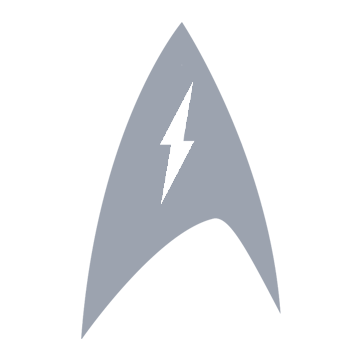Given their scramble for uniforms, Costa wasn’t surprised when he and Hawthorne were the last two senior officers to make it to the bridge. He was just grateful the two of them had ended up in the right color jackets, after all. Their once-again-interrupted conversation had him feeling a lot of things. He was both pleased that Hawthorne had prioritized him, but also angry and disappointed that the decision hadn’t been a conversation that had involved him. There had to be more to it—as he knew that Hawthorne wasn’t the type of man to do things without thinking them through.
The sounds of red alert on the bridge were enough to drive those thoughts off to a corner of his mind to be saved for another time, though. Action was better than any stimulant for focusing his divergent mind. As they stepped out of the turbolift, all Costa could see was the back of his boyfriend’s blonde head, but he firmly agreed with the other man’s assessment of “oh my god” when they parted to take their respective stations. There was a massive, swirling vortex of energy that seemed to be heading directly for Olympia Station.
Costa had never seen anything exactly like it, and yet something about it was familiar. He rushed to take his place at the tactical station next to the helm, tapping security officer Sadir on the shoulder so he could go take his internal security station on the side of the bridge. Tachyon and graviton emissions were off the charts. That wasn’t all that surprising, as every anomaly and its mother in space seemed to spew tachyons, but there also weren’t any traces of exotic particles that you might expect with a black hole or a subspace ellipse or verterons that might come from a wormhole. While not a scientist himself, he’d taken enough astrophysics to qualify as a helm officer and he knew his way around dangerous navigational hazards.
“Eleven of our probes were sucked into that space… hole, sir. That’s as specific as I can get,” Lieutenant Solomon said as Costa caught the last bits of his report to the captain. “We registered an extreme tachyon spike and then this. It’s not like any wormhole I’ve ever read about.”
“That will be all, Mr. Solomon. Take mission ops,” Captain Bennett ordered. “Can someone please tell me what it is and not what it’s not?” he asked.
“If I may, Captain. I know exactly what that is: it’s a subspace corridor. The flight department was briefed on them when Arcturus was assigned to the Delta Quadrant,” Costa interjected, something clicking when Solomon said ‘wormhole.’ Out of the corner of his eye he noticed Solomon’s shoulders slump a little—he was also on that mission, but apparently didn’t make the connection. He made a note to cheer him up later. “They’re very similar to wormholes, but they don’t usually just hang open like this. They’re definitely not supposed to move like that.”
“I’m inclined to agree with the first officer, sir. It explains a set of brief but unusual tachyon readings we detected earlier, sir,” Hawthorne agreed. Hearing his voice made Costa’s stomach do a little somersault, especially since he was validating his analysis. “We thought it was an equipment malfunction, but I should have considered this possibility. Tachyons but no verterons.”
“An entire starbase of scientists missed it, too, so don’t beat yourself up, Mr. Hawthorne,” Bennett said. “Are we getting any readings from our probes that might confirm or deny that assessment?”
“Checking, sir,” Hawthorne said. There was a beat. “Based on the times when each probe stopped reporting data and the maximum range of their transmitters, I calculate that they were traveling at a speed of… Wow. Warp 9.9999965. That’s over twelve thousand times our maximum speed. This is a subspace corridor.”
“Counselor, relay that information to Olympia Station. Admiral Hayden has likely reached the same conclusion, though, considering she led that mission,” he ordered.
Arondight only had one counselor aboard and didn’t have a communications department at all. While on the bridge during alert scenarios, Counselor Wilders sat at the communications station next to Hawthorne’s science station to take some of the workload off of Lieutenant Robinson at operations.
“Sending that along, Captain,” Wilders confirmed. There was a short pause. “Olympia acknowledges. They’re sending us new orders: Five more probes are heading for the event horizon. We are to destroy them before they enter. They’re too valuable to let go into unknown hands. Buran powering up with orders to assist.”
“The probes we just spent three weeks configuring?!” Robinson complained. “Merde.”
“Save the whining for after the crisis, please,” Bennett chided. “Number One, where are our targets?”
Costa brought up the tactical display on the main viewscreen, feeling happily tingly at being called “Number One,” as the novelty had not yet worn off. Probes 2 through 6 were rapidly moving towards the anomaly, and they were well outside of weapons range. They didn’t have much time to intercept and engage.
“We’re two minutes away, and they will be past the event horizon in two minutes twenty,” Costa reported. “I’m arming a full spread of torpedoes. But we have to go now, captain. Once we’ve fired, we’ll need to slingshot around the anomaly, or our momentum is going to take us right into it as well,” he explained.
“Helm, take us to full impulse. Mr. Hawthorne, calculate the slingshot maneuver,” Bennett ordered. He tapped the all-call button on his chair, and Costa heard the boatswain’s whistle sound. “All hands, this is the captain speaking. We are about to execute a high-intensity maneuver. Given unusual graviton effects in local space, be aware that the inertial dampeners may not be able to compensate as quickly as you are accustomed to.”
While the captain was speaking, Costa glanced over at Lieutenant Lassus. The young Trill woman was competent, but as a pilot himself, the first officer couldn’t help but want to step in and handle the maneuver himself. She was awfully quiet for a pilot—a state of existence that Costa just couldn’t fathom.
“We’re at full impulse, Captain,” Lassus reported. “And I have the calculations from the science officer.”
“Buran is out of dock. They’re twenty seconds behind us,” Robinson said from operations.
“Relay our plan to them and request that they stand by for clean-up,” Bennett said. “Let’s not leave anything for them to clean up, though.”
As Arondight streaked towards its targets, Costa kept an eagle eye on the rapidly advancing red circle that indicated the maximum range of the photon torpedo launchers. His secondary training was in tactical, but he hadn’t actually had the opportunity to fire a starship’s weapons very often in his career, which had been primarily at the helm up to that point. Meant to remedy the problems encountered by the fragile Miranda II during the Dominion War, the Reliant was very well armed, and her burst-fire torpedo launchers would be able to wipe those probes off the map with a single volley.
“We’re in range,” Costa reported.
“Fire.”
When Costa hit the firing control, the two forward launchers fired simultaneously. Clusters of torpedoes traveled together for several hundred meters before splitting into two warheads to port and three warheads to starboard. Seconds later, each weapon made successful contact with its target, taking the blue blips off of the strategic display.
“Successful contact, sir,” the first officer said.
With their firing solution complete, the tactical display was taken off of the main viewscreen automatically by the ship’s computer. Costa looked up to see that they were extremely close to the aperture, and it was awe-inspiring: a shimmering sphere of mirrored glass wreathed in brown-orange energy, the visual manifestation of a subspace field interacting with realspace.
“Executing slingshot maneuver,” Lassus reported as she increased power to the impulse engines to flank speed. They got even closer to the anomaly, using the Oberth effect to move far more quickly than they normally could. With deft application of the maneuvering thrusters and timings provided by Hawthorne, Arondight broke out of its dive and shot around the other side of the portal back towards the starbase. “We’re clear.”
“Good job, lieutenant,” Costa said with a nod.
“The Buran is getting far too close to the anomaly!” Hawthorne reported.
“On screen,” Bennett ordered.
The Rhode Island-class starship was edging dangerously close to the aperture. She was trying to turn away from it and run with her impulse engines rather than leaning into the gravity field like Arondight had. Costa’s jaw dropped when he saw the smaller ship’s warp engines begin to glow blue.
“They can’t be… Wilders, tell them to cut warp power now!” Costa ordered.
“Message was received,” Wilders said.
“But not acted upon,” Hawthorne added. Moments later, there was a flash of blue light as Buran attempted to jump to warp. The anomaly doubled in size and pulled the ship right in. It was gone in an instant. “Sir, the Buran’s warp field interacted with the event horizon. They’ve been pulled into subspace, and the anomaly has increased in size. It remains on a direct heading for Olympia Station.”
“We have to go in after them, sir. An event like that would have caused heavy EPS damage,” Costa said, turning to the captain.
Bennett shook his head. “We will if we’re ordered to do so. As of now, we’re the last line of defense for the 40,000 people on that station,” he replied. “Can anyone tell me why that portal is moving in the first place?”
“It’s accelerating,” Robinson warned. “It will make contact with the upper spacedock in less than one minute. The station is firing its maneuvering thrusters, but that won’t give them much more time.”
On the viewer, Costa could see the eight retro thrusters emerging from their covers on the upper surface of the station. Essentially massive fusion engines, they were used to keep the station stable in space. They were never meant to keep it safe from subspace corridors, though. They didn’t have the subspace field driver coils necessary to lower the station’s mass, either, which is how impulse engines were able to take starships to near-relativistic speeds with a fraction of the power and fuel that would require with simple Newtonian physics.
“Olympia is ordering us to proceed away from the anomaly,” Wilders reported. “They believe if we can get under the outer rim of the station, we may be shielded from the effects temporarily.”
“See what you can do, Ms. Lassus,” Bennett ordered.
“What happens when the anomaly hits the station?” Costa asked.
“Well, the aperture is now two kilometers across, and the station is nearly four kilometers across, so, if the station’s shields don’t hold, it’ll be shredded,” Robinson said.
“I think I’ve figured it out, captain. The aperture is being drawn to the subspace radio amplifier. It’s tied into the station’s primary fusion reactors, which makes it an order of magnitude more powerful than our warp engines. It’s acting like a magnet,” Hawthorne said. “If they could invert the field, it might repel it.”
“That would take hours,” Robinson said. “Too late, anyway. The upper edge of the station has made contact. Shields are holding.”
“We’re being ordered to retreat,” Wilders said.
Bennett sighed. “We have to go get help,” he said. “Helm, get us out of here.”
Costa saw Lassus hit the maneuvering thrusters, but as soon as their angle of attack changed, they started moving rapidly towards the ventral surface of the main spacedock. She quickly corrected to return to a parallel course with the station, but they were stuck in space even at full impulse.
“I can’t overcome the force of the gravitational field, sir,” Lassus reported.
“And we’ve seen what the warp engines will do…,” Costa said, his mind whirling for a solution.
“Captain, the station’s shields are forcing the aperture to open wider. At this rate, the station will enter the subspace corridor in twenty seconds,” Hawthorne reported.
“Olympia should still have the enhanced inertial dampeners she was fitted with when she was moved into position. Let’s hope her structural integrity fields hold, too,” Bennett said as he moved forward to stand next to Costa. He examined the helm and tactical consoles. “It looks like there’s no way we can avoid entering this corridor. Once Olympia goes in, we’ll have maybe two or three seconds, and then we’ll be entering backward. If we change orientation before that, we won’t have enough power to avoid crashing into the station. Both are bad options.”
“Agreed,” Costa said. “If the station could extend their shields around us, they could hold us in place with tractor beams, and we could ride along with them,” he suggested.
“As good a plan as any. Olympia, Arondight. We are unable to depart. Request that you extend shields and hold us in place with tractor beams. Otherwise, we risk impacting the station,” Bennett said, triggering ship-to-station communications himself.
“It’s going to be a bumpy ride, Arondight. We’ll get you under our shields,” Commodore Logan replied from the station’s operations center. “Once we have our tractor beams on you, you will need to cut impulse power immediately.”
“Understood,” Bennett said. “You heard the commodore, everyone. Let’s get it done,” he said before returning to his seat. “All hands, brace for impact.”
There was a shimmer of blue on the screen as the station’s shields expanded to cover Arondight, and then a massive shudder that nearly threw Costa out of his seat. Lassus cut impulse power, and they could all see the ship being whipped around by the station’s massive tractor beams until the viewscreen was filled with the blue glow of the ventral sensor arrays under the station’s mushroom-shaped spacedock. The tractor beams continued until Arondight landed with a thud and a shudder on the outer hull of the station’s lower spacedock. There was no time to get them inside the dock. Moments later, the shields flashed again as they switched from bubble mode to hull-conformal mode, forming a protective skin over the Arondight.
“We’re going in!” Costa reported.
The massive Spacedock-class station was pulled into the aperture leading into the subspace corridor. The bridge rocked again, but the tractor beam held. All around the ship, the shimmering brown-gold energy fields they had seen from outside the anomaly began to buffet the shields as the station moved at phenomenal speeds toward an unknown destination. If this corridor was average, they would go dozens of light-years in just seconds, and there was no way to predict where the other end of the tunnel would lead. What none of them knew was what the effects of a four-kilometer-wide station punching its way through subspace might do.
Meanwhile, Arcturus was a three-day journey from the Olympia System at high warp on a mission to conduct first contact with a new species. On the bridge, Lieutenant Matthew Belvedere was in the midst of downloading their daily upload from Olympia, which included intelligence data and crew letters. They were outside of real-time range with their home port but close enough for asynchronous transmissions. Interruptions weren’t uncommon, but it was concerning when it didn’t re-connect after a few minutes. The communications officer looked at the strategic map to see what the chain of starships back to the station looked like.
Antares was a day behind them and a day out from Renown, which should have been in range of Arondight or Buran if not the station itself.
“Antares, Arcturus. Please relay a status check to Olympia through Renown,” Belvedere said over the long-range communications.
“Arcturus, Antares. Understood,” his counterpart on Antares replied.
Belvedere didn’t have to wait long for a response to his interstellar game of telephone.
“Arcturus, Antares. Olympia is non-responsive on any channel. Renown is unable to verify position or status of Olympia, Arondight, or Buran on sensors.”
Belvedere sighed. It was going to be one of those days. “Understood. Thank you. Stand by for further orders,” the young man said. He tapped a key for internal communications. “Captain to the bridge,” he ordered. “One of our starbases is missing.”

 Bravo Fleet
Bravo Fleet












